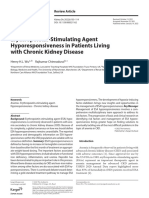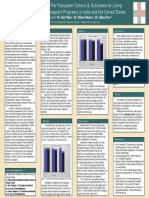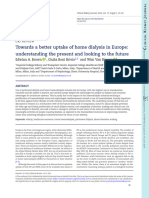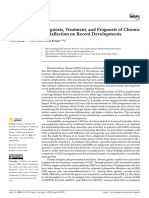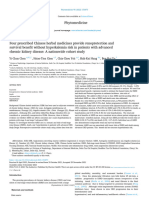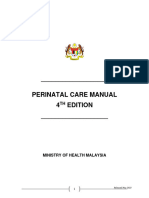ESRD
ESRD
Uploaded by
yena hillCopyright:
Available Formats
ESRD
ESRD
Uploaded by
yena hillOriginal Title
Copyright
Available Formats
Share this document
Did you find this document useful?
Is this content inappropriate?
Copyright:
Available Formats
ESRD
ESRD
Uploaded by
yena hillCopyright:
Available Formats
See discussions, stats, and author profiles for this publication at: https://www.researchgate.
net/publication/26255708
End-stage renal disease in Indonesia: Treatment development
Article in Ethnicity & Disease · February 2009
Source: PubMed
CITATIONS READS
54 3,538
2 authors, including:
Suhardjono Suhardjono
University of Indonesia
21 PUBLICATIONS 189 CITATIONS
SEE PROFILE
Some of the authors of this publication are also working on these related projects:
CKD In Indonesia View project
All content following this page was uploaded by Suhardjono Suhardjono on 03 December 2015.
The user has requested enhancement of the downloaded file.
END-STAGE RENAL DISEASE IN INDONESIA: TREATMENT DEVELOPMENT
The number of cases of chronic kidney disease Wiguno Prodjosudjadi, MD, PhD; A. Suhardjono, MD, PhD
is growing rapidly, especially in the developing
world. At a certain level of renal function,
progression of chronic kidney disease to end-
stage renal disease (ESRD) is inevitable. ESRD
INTRODUCTION ment hospitals. Specifically designed
has become a major health problem because it
questionnaires were distributed among
is a devastating medical condition, and the In developing countries, infectious the centers. Thirteen selected centers
cost of treatment is a huge economic burden. disease is still a leading cause of were included in this study, and they
This article presents data collected from 13 morbidity and mortality; however, car- provided data concerning RRT for
nephrology centers in response to specifically diovascular and other noninfectious ESRD patients. Eleven of 13 centers
designed questionnaires. These centers were
cause are also increasing significantly. were nephrology units of university
divided into 7 groups on the basis of
geographic location. Previous data had given In Indonesia, numbers of chronic hospitals. Data of ESRD patients who
the impression that the incidence and preva- kidney disease patients are rising rapid- underwent hemodialysis and CAPD
lence of ESRD had increased, and the results of ly. It has become a devastating medical, from 2002 until 2006 were recorded.
this study support these previous data. Since a social, and economic problem for Monthly data of new ESRD patients
national registry of ESRD has just been
patients and their families. requiring dialysis in the current year
developed for Indonesia and we can present
only limited data in this study, the numbers in Previous limited data give the im- have been provided. Information con-
this article underestimate the true incidence pression that both incidence and preva- cerning kidney transplantation was ob-
and prevalence rates. Although hemodialysis lence of ESRD in various areas of Java tained from a few centers only.
facilities have been developed rapidly, further and Bali were increasing over time.1 This Incidence was derived from the
development is still required. Continuous conclusion was based on the data pro-
ambulatory peritoneal dialysis as an alternative number of new patients entering RRT
renal replacement therapy (RRT) is only now
vided by a few nephrology and dialysis programs in the current year, while the
being introduced. Kidney transplantation pro- centers, thus limiting the ability to project incidence rate was the number per
grams expand very slowly. RRT still imposes a the situation throughout the country. million. The prevalence was defined as
high cost of treatment for ESRD; therefore, Modalities of treatment for ESRD
these treatments are unaffordable for most
numbers of ESRD patients on RRT
have been developed and grown rapidly,
patients. Recently, government health insur- alive on December 31 in the current
although the treatment costs are still
ance has covered financially strained families year, while the prevalence rate repre-
unaffordable for most patients. Hemodi-
requiring RRT. Since the cost of RRT for ESRD sents the number per million people.3
has significantly increased over time, the alysis has become a part of routine
Data provided by 13 centers included in
management approach should be shifted from medical care for ESRD but still imposes
treatment to prevention. (Ethn Dis. this study were divided into 7 groups on
high costs of treatment. Previous data
2009;19[Suppl 1]:S1-33–S1-36) the basis of geographic location. The
showed that the burden for the medical
population figures of the geographic
Key Words: End-stage Renal Disease, Inci- care of ESRD treatment has increased
areas were obtained from the Central
dence, Prevalence, Treatment Development substantially. In 2000, the government
Board of Statistics.4
health insurance reimbursed the costs for
Data on the financing system for
hemodialysis as much as 33 billion rupiah
ESRD treatment were provided by the
($3,606,557), a figure three times that
government health insurance5 and un-
reported in 1995.2 Continuous ambula-
tory peritoneal dialysis (CAPD) and published data of the Indonesian Soci-
kidney transplantation have also been ety of Nephrology. Classification of the
offered as renal replacement therapy underlying diseases of ESRD patients
(RRT) alternatives for ESRD. who underwent dialysis is also reported
The purpose of this study was to in this study.
evaluate the magnitude of ESRD prob-
From the Division of Nephrology and
lems related to the incidence, preva-
Hypertension, Department of Internal Med-
icine, Faculty of Medicine University of lence, and treatment. RESULTS
Indonesia, Jakarta, Indonesia (WP, S).
Figure 1 shows the distribution of
Address correspondence and reprint MATERIALS AND METHODS hemodialysis, CAPD, and kidney trans-
requests to: Wiguno Prodjosudjadi; Faculty plantation centers in Indonesia. The 7
of Medicine, University of Indonesia; Jl.
Diponegoro No. 71, Jakarta Pusat 10430, Data presented in this article were groups based on the geographic varia-
Indonesia; 62-21-3102868; pernefri@cbn. derived from a number of nephrology tions included in this study are also
net.id centers within both private and govern- depicted in this figure. Four geographic
Ethnicity & Disease, Volume 19, Spring 2009 S1-33
END-STAGE RENAL DISEASE TREATMENT - Prodjosudjadi and Suhardjono
Fig 1. Distribution of dialysis centers and seven geographic areas studied
areas represent Java Island, Sumatra, went dialysis were glomerulonephritis years, the CAPD program has been
Bali, and the eastern part of Indonesia. (36.4%), obstructive and infective kidney developing more rapidly, and recent data
According to Central Board Statistics diseases (24.4%), diabetic kidney disease show that the numbers of ESRD patients
data, the year 2006 total population was (19.9%), hypertension (9.1%), other on CAPD have now reached almost 500.
219.2 million. Almost 58.3% lived in causes (5.2%), unknown cause (3.8%), This is <10% of the total ESRD patients
Java Island, 21.1% in Sumatra, 5.7% in and polycystic kidney disease (1.2%). who receive HD.
Borneo, and 14.8% in the eastern part
of Indonesia, including Bali.4 Modalities of ESRD Treatment Kidney Transplantation
Data concerning kidney transplan-
Incidence, Prevalence, and Dialysis tation are very limited, and they were
Causes of Treated ESRD Hemodialysis has become the rou- provided by only a few centers. Kidney
The incidences of ESRD patients tine medical treatment for ESRD. It is transplantation was first performed at
who underwent hemodialysis from estimated that more than 250 hemodi- Cipto Mangunkusumo Hospital, a
2002 through 2006 were 2077, 2039, alysis units are distributed throughout teaching hospital of the Medical Facul-
2594, 3556, and 4344, respectively. the country. Data show that more than ty, University of Indonesia, Jakarta, in
The incidence rates per million popula- 1600 dialysis machines are now avail- 1977. Kidney transplantation has also
tion in each year were 14.5, 14.0, 18.0, able and distributed among hemodialy- been performed in 3 other centers. The
24.6, and 30.7, respectively. The prev- sis units. Hemodialysis is commonly total number of kidney transplants
alences of ESRD patients on hemodial- performed twice a week for 4–5 hours performed from 1977 to 2006 in these
ysis from 2002 through 2006 were per session in most ESRD patients. centers was 476.
1425, 1656, 1908, 2525, and 3079, Dialysate fluids are mostly bicarbonate Most kidneys are obtained from
consecutively. The prevalence rates per based. Most of the dialysis units offer living related donors, since kidneys from
million populations were 10.2, 11.7, hemodialysis only. cadaveric donors are not fully accepted
13.8, 18.4, and 23.4, respectively. CAPD as an alternative dialysis yet because of social and cultural prob-
Tables 1 and 2 show incidence and therapy for ESRD is offered in 5 of the lems, lack of a legal process, and lack of
prevalence of RRT for ESRD by area, 13 centers included in this study, which technical ability to carry out these
2002 and 2006. use 3–4 fluid exchanges per day. This procedures. The shortage of living donors
Data from a few centers reported that program started in Jakarta in 1999 and has become a serious problem in kidney
causes of ESRD in patients who under- has been increasing slowly. In the last 3 transplantation; therefore, many patients
S1-34 Ethnicity & Disease, Volume 19, Spring 2009
END-STAGE RENAL DISEASE TREATMENT - Prodjosudjadi and Suhardjono
Table 1. Incidence of renal replacement therapy for end-stage renal disease by area, Indonesia, 2002 and 2006
2002 2006
RRT Modality Total New Incidence Rate RRT Modality Total New Incidence Rate
Patients per Million Patients per Million
Area HD CAPD Transplant on RRT Population HD CAPD Transplant on RRT Population
West Java 176 0 0 176 4.7 886 33 0 919 23.5
Central Java 792 7 4 803 23.0 1219 108 1 1328 37.8
East Java 255 0 0 255 7.2 695 0 0 695 19.5
Jakarta 452 55 6 513 61.2 659 96 10 765 87.9
Sumatra 164 0 0 164 8.6 378 45 0 423 22.0
Bali 49 0 0 49 15.2 137 19 0 156 46.2
East Indonesia 189 0 0 189 18.3 370 0 0 370 34.8
Total 2077 62 10 2149 14.5 4344 301 11 4656 30.7
RRT 5 renal replacement therapy, HD 5 hemodialysis, CAPD 5 continuous ambulatory peritoneal dialysis.
undergo kidney transplantation abroad. allograft loss and returned to hemodial- cluding treatment for ESRD. Recent
The cost of kidney transplantation and ysis, and 3 patients died with a data show that the financial burden for
the requisite immunosuppressive agents functioning kidney allograft because of ESRD treatment increased from
and both the quantity and quality of cerebrovascular disease, septicemia, or $5,776,565 in 2002 to $7,691,046 in
human resources should also be consid- heart failure within 1 year of transplan- 2006. Government health insurance
ered major problems. tation. data in 2006 showed that 4946 hemo-
Data from 3 kidney transplantation Triple-drug therapy is standard im- dialysis patients and 263 CAPD pa-
centers showed that 49 ESRD patients munosuppressive therapy in kidney tients were insured through socialized
entered a kidney transplantation pro- transplantation. The immunosuppres- health insurance. An estimated 15
gram from 2002 through 2006. Kidney sive drug combination consists of either million people have benefited from this
transplantation from emotionally relat- cyclosporine A, azathioprine, and a insured medical care facility. Recently,
ed donors is now also accepted. Single corticosteroid or tacrolimus, mycophe- underprivileged people have also been
center data show that of 31 kidney nolic mofetil, and a corticosteroid. The covered by the government through the
transplantations, 8 kidneys were ob- dose of tacrolimus or cyclosporine A is Financially Unfavorable Family Health
tained from spouses and close relatives adjusted according to blood monitoring Insurance. This program started in
(emotionally related donors), 4 from and time since the transplant and 2005 and was expected to cover 60
parents to children, 2 from children to stability. Cyclosporine A levels at C0 million people, and it includes ESRD
parents, and the rest from siblings. or C2 can be measured. treatment. In 2006, as many as 5418
Overall, 1-year graft survival is difficult ESRD patients from poor families were
to calculate because of the limited data Financing System insured by the government.5 For those
provided in this study. From 31 kidney Government health insurance covers included in this program, all costs for
transplantations, 5 patients had renal government hospital medical care, in- hemodialysis and CAPD with 3 fluid
Table 2. Prevalence of renal replacement therapy for end-stage renal disease by area, Indonesia, 2002 and 2006
2002 2006
RRT Modality Total Prevalence Rate RRT Modality Total Prevalence
Patients per Million Patients Rate per Million
Area HD CAPD Transplant on RRT Population HD CAPD Transplant on RRT Population
West Java 67 0 0 67 1.8 190 26 0 216 5.5
Central Java 579 3 18 600 17.2 1227 156 16 1399 39.8
East Java 139 0 0 139 3.9 326 0 0 326 9.2
Jakarta 356 65 6 427 50.9 728 151 47 926 106.4
Sumatra 118 0 0 118 6.2 238 41 0 279 14.5
Bali 61 0 0 61 18.9 187 33 0 220 65.1
East Indonesia 105 0 0 105 10.2 183 0 0 183 17.2
Total 1425 68 24 1517 10.2 3079 407 63 3549 23.4
RRT 5 renal replacement therapy, HD 5 hemodialysis, CAPD 5 continuous ambulatory peritoneal dialysis.
Ethnicity & Disease, Volume 19, Spring 2009 S1-35
END-STAGE RENAL DISEASE TREATMENT - Prodjosudjadi and Suhardjono
exchanges are covered by government important source of information on ACKNOWLEDGMENTS
health insurance, while CAPD with 4 several aspects of ESRD, including We thank Endang Susalit (Cipto Mangun-
fluid exchanges is only covered at 80%. etiology, treatment modalities, and kusumo Hospital, Jakarta), Tunggul Situ-
morang (Christian Cikini Hospital, Jakarta),
Costs for kidney transplantation are also trends of morbidity and mortality.2,9
Adenan Irianto (PIK Hospital, Jakarta),
covered partly by government health Central Board Statistics of Indonesia Rully M.A. Roesli (Hasan Sadikin Hospital,
insurance. reported that in 2005 the total popula- Bandung), Lestariningsih (Kariadi Hospital,
tion was 219.2 million.4 In 2006, Semarang), H.R. Moh Yogiantoro (Soe-
government health insurance data tomo Hospital, Surabaya), Syakib Bakri
DISCUSSION showed that 5000 ESRD patients were (Wahidin Sudirohusodo Hospital, Makas-
sar), Harun R. Lubis (Pirngadi Hospital,
dialyzed, for an estimated prevalence
Chronic kidney disease is a public Medan), Mochammad Sja’bani (Sardjito
rate of 357 per million population. If Hospital, Yogyakarta), Ketut Suwitra (San-
health problem for both developed and this number reflects the true national glah Hospital, Denpasar, Bali), Bambang
developing countries. At a certain level prevalence, nearly 80,000 people would Purwanto (Moewardi Hospital, Solo), Ian
of renal function, the progression of have had ESRD in 2006 in the whole Effendi (Moh Hoesin Hospital, Palem-
kidney disease to ESRD is inevitable. country. As many as 4946 hemodialysis bang), and Emma Sjarifah Moeis (Kandau
Worldwide data show that .1 million patients and 263 CAPD patients are Hospital, Manado) for providing data
ESRD patients are on RRT, while as presented in this article.
insured by socialized government health
many as 2 million more are in need of insurance, while 5418 patients are
such therapy.6,7 In developing coun- REFERENCES
insured by ‘‘Financially Unfavorable 1. Prodjosudjadi W. Incidence, prevalence, treat-
tries, accessibility to RRT is still limited
Family Health Insurance.’’5 If the ment and cost of end-stage renal disease in
for most ESRD patients because RRT is Indonesia. Ethn Dis. 2006;16(2):S2-14–S2-16.
private insurance company covers 1785
expensive, especially in the absence of 2. Prodjosudjadi W. Chronic renal failure cause
patients calculated from 5 million by glomerular disease: role of medical educa-
national insurance programs.
people with the same prevalence rate, tion and professionalism in their prevention.
As reported in other developing
12,412 or 15.5% of all ESRD patients Professor lecture, faculty of medicine, Univer-
countries,8 the true magnitude of ESRD sity of Indonesia; 2001.
requiring dialysis have been treated. The
in Indonesia remains unknown. Pre- 3. National Institutes of Health. United States
total costs of dialysis treatment have
dicted numbers of ESRD requiring Renal Data System 2002 annual data report:
become a burden for the government. atlas of end-stage renal disease in the United
RRT are not known since a national
In India and Pakistan, treatment of States. Chapter 1, incidence and prevalence.
registry for ESRD has only recently
ESRD is still a low priority for cash- Am J Kidney Dis. 2003;41(Suppl 2):S41–S56.
been developed. Incidence, incidence 4. Statistical Year Book of Indonesia. Central
strapped public hospitals, and less than
rates, prevalence, and prevalence rates Board of Statistics, 2005.
10% of all patients receive RRT.10
presented in this study are far lower 5. Government health insurance data. Division of
Most dialysis units provide hemodi- Health Services, Socialized Health Insurance.
than those expected because data from
alysis only; therefore, dialysis choices Personal Communication. April 2007.
dialysis centers included in this study
have been offered only in those centers 6. Lysaght MJ. Maintenance dialysis population
were limited. Consequently, the pre- dynamics: current trends and long-term impli-
where both hemodialysis and CAPD
sented data do not represent the cation. J Am Soc Nephrol. 2002;13:37:37–40.
facilities are available. While patients’
national data. However, results of this 7. Xue JL, Ma JZ, Louis TA, Collins AJ. Forecast
preferences and their medical or clinical of the number of patients with end-stage renal
study indicate increasing trends of
conditions are considered first in the disease in United State to year 2010. J Am Soc
incidence and prevalence of ESRD. In
selection of dialysis modality, the acces- Nephrol. 2001;12:2753–2758.
this study, the incidence numbers 8. Agarwal SK. Chronic kidney disease and its
sibility of the treatment facility and
appear to exceed those for prevalence prevention in India. Kidney Int. 2005;68(Suppl
healthcare financing systems also play a
because of high numbers of patients 98):S41–S45.
who die during dialysis or withdraw role. Kidney transplantation programs 9. National Institutes of Health. United States Re-
from the program. In this study, glo- are less well developed than are other nal Data System 2004 annual data report: atlas
modalities of treatment. The shortage of of end-stage renal disease in the United States.
merulonephritis was the leading cause of Am J Kidney Dis. 2005;45(Suppl 1):S41–S87.
ESRD among patients in a dialysis donors needs to be overcome and high
10. Sakhuja V, Sud K. End-stage renal disease in
program, which is consistent with find- success rates for this procedure achieved India and Pakistan: burden of disease and
ings of previous reports.1 A renal registry, before prospective donors can be ap- management issue. Kidney Int. 2003;63(Suppl
when fully operational, would offer an proached with confidence. 83):115–118.
S1-36 Ethnicity & Disease, Volume 19, Spring 2009
You might also like
- Legal Opinion 93-11Document14 pagesLegal Opinion 93-11billmoscaNo ratings yet
- Detailed Hospital Strategic Plan ExampleDocument19 pagesDetailed Hospital Strategic Plan ExampleEsteban R. Langlois100% (1)
- Epidemiologi GGKDocument10 pagesEpidemiologi GGKOctavianus KevinNo ratings yet
- Prevalence of Chronic Kidney Disease in Asia A SysDocument9 pagesPrevalence of Chronic Kidney Disease in Asia A Syslaila.rochma08No ratings yet
- Brown Et Al 2017 Length of Time On Peritoneal Dialysis and Encapsulating Peritoneal Sclerosis Position Paper For IspdDocument13 pagesBrown Et Al 2017 Length of Time On Peritoneal Dialysis and Encapsulating Peritoneal Sclerosis Position Paper For IspdGema CanalesNo ratings yet
- Distress Manifestations Experienced and Coping Strategies Employed by Patients With End-Stage Renal DiseaseDocument13 pagesDistress Manifestations Experienced and Coping Strategies Employed by Patients With End-Stage Renal DiseaseInternational Journal of Innovative Science and Research TechnologyNo ratings yet
- KDD 0008 0103 2Document12 pagesKDD 0008 0103 2BelajarNo ratings yet
- The Impact of Chronic Kidney Disease On Developed Countries From A Health Economics Perspective: A Systematic Scoping ReviewDocument19 pagesThe Impact of Chronic Kidney Disease On Developed Countries From A Health Economics Perspective: A Systematic Scoping ReviewWalter Espriella CastellarNo ratings yet
- 1281 Full-3 PDFDocument6 pages1281 Full-3 PDFMentari SyarifuddinNo ratings yet
- Rheumatic Heart Disease Severity, Progression and Outcomes: A Multi-State ModelDocument15 pagesRheumatic Heart Disease Severity, Progression and Outcomes: A Multi-State ModelrosaNo ratings yet
- 2017 USRDS Annual Data Report Executive SummaryDocument8 pages2017 USRDS Annual Data Report Executive SummaryTony Miguel Saba SabaNo ratings yet
- Kulit 5Document1 pageKulit 5Anonymous 12QYPATm3No ratings yet
- Reviews: Nephrology in ChinaDocument6 pagesReviews: Nephrology in ChinaAshan HasanthaNo ratings yet
- 7.+ (En) +wulandari+47 56+revDocument10 pages7.+ (En) +wulandari+47 56+revyanuar esthoNo ratings yet
- Ijerph 18 00538Document11 pagesIjerph 18 00538sayesha tanejaNo ratings yet
- Sukriti Bansal Dr. Hari Raja, Dr. Nilum Rajora, Dr. Vijay KherDocument1 pageSukriti Bansal Dr. Hari Raja, Dr. Nilum Rajora, Dr. Vijay KherRajat KashyapNo ratings yet
- An Appraisal of Nephroprotection and The Scope of Natural Products in Combating Renal DisordersDocument6 pagesAn Appraisal of Nephroprotection and The Scope of Natural Products in Combating Renal DisordersadilnnjNo ratings yet
- Public Policy Series: Allen R. NissensonDocument5 pagesPublic Policy Series: Allen R. NissensonRiki RijaludinNo ratings yet
- Prevalence and Risk Factors For ChronicDocument10 pagesPrevalence and Risk Factors For ChronicKhoirul AnamNo ratings yet
- Nair Et Al. 2016 - Frequent Home Haemodialysis, A Review of The EvidenceDocument8 pagesNair Et Al. 2016 - Frequent Home Haemodialysis, A Review of The EvidenceShareDialysisNo ratings yet
- Blood Transfusion During Hemodialysis: An Evidence-Based ProcedureDocument6 pagesBlood Transfusion During Hemodialysis: An Evidence-Based ProcedureAmalNo ratings yet
- Chen 2017Document14 pagesChen 2017mirantiNo ratings yet
- EditorialDocument2 pagesEditorialmanfel_26No ratings yet
- DD Pooled StudyDocument11 pagesDD Pooled StudyMahbubul HoqueNo ratings yet
- Analgesic Use Parents Clan and Coffee Intake Are Three Independent Risk Factors of Chronic Kidney Disease in Middle and Elderly Aged Population ADocument7 pagesAnalgesic Use Parents Clan and Coffee Intake Are Three Independent Risk Factors of Chronic Kidney Disease in Middle and Elderly Aged Population AJackson HakimNo ratings yet
- Balhara Et Al. (2020)Document9 pagesBalhara Et Al. (2020)Katherine McLemoreNo ratings yet
- Growth of The ESKD Population Progress or Peril .3Document2 pagesGrowth of The ESKD Population Progress or Peril .3Arista RachmaNo ratings yet
- Ing GrisDocument2 pagesIng Grisvia lattansaNo ratings yet
- Kidney Transplantation in India Challenges And.3Document6 pagesKidney Transplantation in India Challenges And.3Sam InvincibleNo ratings yet
- Associations Between Socioeconomic Status and CKD A MetanalysisDocument10 pagesAssociations Between Socioeconomic Status and CKD A MetanalysismussaNo ratings yet
- SurvivalDocument7 pagesSurvivalFuad HadiNo ratings yet
- Jurnal PubmetDocument8 pagesJurnal PubmetRinda novitaNo ratings yet
- 05 N111 39956Document28 pages05 N111 39956Mahruri SaputraNo ratings yet
- Epidemiological Profile An Important Step in The ODocument3 pagesEpidemiological Profile An Important Step in The ODelma ChinavaneNo ratings yet
- PD Vs HD in Europe - 2004Document10 pagesPD Vs HD in Europe - 2004Kezumath TheForsakenNo ratings yet
- Primary Prevention For Rheumatic Fever: Progress, Obstacles, and OpportunitiesDocument7 pagesPrimary Prevention For Rheumatic Fever: Progress, Obstacles, and OpportunitiesSiq Febri SmnjtkNo ratings yet
- Applsci 14 05518 v2Document3 pagesApplsci 14 05518 v2otdelseocherkassyNo ratings yet
- Artigo - Pacientes Com DRCDocument9 pagesArtigo - Pacientes Com DRCRainiela Braz CanutoNo ratings yet
- Strokeaha 110 610881Document5 pagesStrokeaha 110 610881Damilola AdediniNo ratings yet
- Global Dialysis Perspective Mexico.15Document4 pagesGlobal Dialysis Perspective Mexico.15ivanNo ratings yet
- Prevalence and Associated Factors of Frailty and MortalityDocument12 pagesPrevalence and Associated Factors of Frailty and Mortalityor1da2sa3No ratings yet
- Dean Et Al. 2014 - Global Prevalence of Ankylosing SpondylitisDocument8 pagesDean Et Al. 2014 - Global Prevalence of Ankylosing SpondylitismuamarrayNo ratings yet
- Jurnal 2 PDFDocument15 pagesJurnal 2 PDFyurika chairaniNo ratings yet
- Pages From June04 Ch2Document12 pagesPages From June04 Ch2junebabeNo ratings yet
- Sceintific Writing 1Document5 pagesSceintific Writing 1ibrahimNo ratings yet
- Cureus 0012 00000010358Document19 pagesCureus 0012 00000010358Bertha FransiscaNo ratings yet
- JANH V4N1 - Ce2 132-139Document8 pagesJANH V4N1 - Ce2 132-139b4q786ww8vNo ratings yet
- Model Promosi Kesehatan Dalam Pencegahan Dan Penanggulangan Penyakit DBD Melalui Gerakan 3 M Plus Di Kota PekanbaruDocument12 pagesModel Promosi Kesehatan Dalam Pencegahan Dan Penanggulangan Penyakit DBD Melalui Gerakan 3 M Plus Di Kota PekanbaruAbiReknantoNo ratings yet
- Healthcare SpendingDocument20 pagesHealthcare Spendingmikeb92556No ratings yet
- Chronic Kidney Disease PDFDocument6 pagesChronic Kidney Disease PDFAnonymous YxrygUxNo ratings yet
- Pamj 45 175Document10 pagesPamj 45 175Nur AiniNo ratings yet
- Cfs 8 PDFDocument9 pagesCfs 8 PDFDaniel Fernando Mendez CarbajalNo ratings yet
- 2018 Article 989Document9 pages2018 Article 989Evan Nanda AdilistyaNo ratings yet
- Organisation of Reperfusion Therapy For STEMI in A Developing CountryDocument8 pagesOrganisation of Reperfusion Therapy For STEMI in A Developing CountryJimmy JimmyNo ratings yet
- Detection and Prevention of Chronic Kidney Disease in Indonesia: Initial Community ScreeningDocument6 pagesDetection and Prevention of Chronic Kidney Disease in Indonesia: Initial Community ScreeninghukamaNo ratings yet
- Vol2 USRDS ESRD 15Document274 pagesVol2 USRDS ESRD 15Bogdan Marian SorohanNo ratings yet
- Global Prevalence of Chronic Kidney Disease - A Systematic Review and Meta-AnalysisDocument18 pagesGlobal Prevalence of Chronic Kidney Disease - A Systematic Review and Meta-AnalysisMellya RizkiNo ratings yet
- CTS MHDDocument8 pagesCTS MHDTheodoreNo ratings yet
- CKD BaselineDocument10 pagesCKD BaselinekundunayanikaNo ratings yet
- DPN - Iberoamericanjm-3-1-18Document8 pagesDPN - Iberoamericanjm-3-1-18ganesh raoNo ratings yet
- Prediction of Chronic Kidney Disease Using Machine Learning Techniques - PaperDocument11 pagesPrediction of Chronic Kidney Disease Using Machine Learning Techniques - PaperChamarthy SribharathicharanNo ratings yet
- Dialysis Access ManagementFrom EverandDialysis Access ManagementSteven WuNo ratings yet
- Literature Review On HerbalDocument5 pagesLiterature Review On HerbalShreyansh RavalNo ratings yet
- GoodPractice WL U01ReceivingPatientDocument3 pagesGoodPractice WL U01ReceivingPatientReka Kutasi100% (1)
- World Health Report 2012: No Health Without A ResearchDocument151 pagesWorld Health Report 2012: No Health Without A ResearchInternational Medical Publisher100% (1)
- Q1.IMG Vs IMGL+Corticoides. Sin ResultadosDocument10 pagesQ1.IMG Vs IMGL+Corticoides. Sin ResultadosMari Carmen GrandasNo ratings yet
- Extra: First Fictional Report of Folie A' DeuxDocument2 pagesExtra: First Fictional Report of Folie A' DeuxrocolmarNo ratings yet
- Nursing Clinical Resume1Document3 pagesNursing Clinical Resume1api-396119949No ratings yet
- Jozie Annotated BibliographyDocument10 pagesJozie Annotated Bibliographyapi-450935011No ratings yet
- Theatre LogbookDocument44 pagesTheatre LogbookDerick NKANDU KALUBANo ratings yet
- Kaitlin Young ResumeDocument2 pagesKaitlin Young Resumeapi-305636300No ratings yet
- Chaos Aug 2016Document165 pagesChaos Aug 2016Mohamed SaberNo ratings yet
- NCP For Preterm LaborDocument2 pagesNCP For Preterm LaborP Sta Maria75% (4)
- Kelas Terapi Sub Terapi Nama Generik Kekuatan Sediaan Generik Bentuk Sediaan Merk Dagang Gagasan Analgetik Analgetic Non Narkotik Kapl 500mg, SirupDocument4 pagesKelas Terapi Sub Terapi Nama Generik Kekuatan Sediaan Generik Bentuk Sediaan Merk Dagang Gagasan Analgetik Analgetic Non Narkotik Kapl 500mg, SirupDjulia Shiendy Soes ArdiantiNo ratings yet
- Perinatal Care Manual 4th Edition 2020 11mei2023Document460 pagesPerinatal Care Manual 4th Edition 2020 11mei2023hgp9ms5gjcNo ratings yet
- AIAPGET 2024 ClassesDocument10 pagesAIAPGET 2024 ClassesGuna SoundariNo ratings yet
- Eleanor HolmesDocument3 pagesEleanor HolmesOmaima AhmedNo ratings yet
- Key Components of TBI Rehabilitation: Clinical Practice GuidelineDocument15 pagesKey Components of TBI Rehabilitation: Clinical Practice GuidelineAnonymous 2dpI8P7n2WNo ratings yet
- 220-Article Text-367-1-10-20210712Document10 pages220-Article Text-367-1-10-20210712syifa wahyu prakosoNo ratings yet
- Postpartum SafetyDocument4 pagesPostpartum Safetyazida90No ratings yet
- Ethics Exercise LeadershipDocument2 pagesEthics Exercise Leadershipapi-704084699No ratings yet
- Manulife Costco All Inclusive Policy Travel Insurance Canadians Policy enDocument17 pagesManulife Costco All Inclusive Policy Travel Insurance Canadians Policy enSara AdelNo ratings yet
- Czech Private Health Insurance FraudDocument5 pagesCzech Private Health Insurance FraudcrazybearNo ratings yet
- Please Search On The Filipino Cultural Characteristics and Health Care Beliefs and Practices in Health EducationDocument16 pagesPlease Search On The Filipino Cultural Characteristics and Health Care Beliefs and Practices in Health Educationthe someoneNo ratings yet
- St. Paul University PhilippinesDocument4 pagesSt. Paul University PhilippinesSuzete PagaduanNo ratings yet
- Could Cannabis Help You Sleep - Jennifer Walsh - TEDxKingsParkSalon - English - Generated)Document10 pagesCould Cannabis Help You Sleep - Jennifer Walsh - TEDxKingsParkSalon - English - Generated)Vo Minh TriNo ratings yet
- Jurnal Reading PanumDocument28 pagesJurnal Reading PanumIdris MohammadNo ratings yet
- Maximizing Success With Rapid Sequence IntubationsDocument11 pagesMaximizing Success With Rapid Sequence IntubationsRaymond RosarioNo ratings yet
- Built With Science Fat Loss Meal Plan PDFDocument18 pagesBuilt With Science Fat Loss Meal Plan PDFgouraiahnagaNo ratings yet
- Lesson 1-Documentation and ReportingDocument8 pagesLesson 1-Documentation and ReportingCHRISTIAN ROY MAXINO100% (1)






